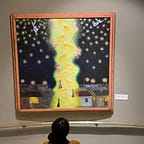My Body, My Artistic Choice
A look at how Ana Mendieta body art speaks for women
Mendieta had an early exposure to violence at a young age. She moved to America in the ’60s as a child to escape Cuba’s Castro revolts. Later in the ’70s, Mendieta’s work did not shy away from the topic of violence, especially about women. While at the University of Iowa, the murder of a student began to shape many of her work. She portrays the violent pressure society puts on women by pushing her body and face against a glass wall. In Glass on Body Imprint/Glass on Face (1972), she uses her nude body to aggressively push herself against the glass. She pushes so hard, her body appears squished and flat. She doesn’t hold back from the glass barrier. She appears as if she is physically trying to go through this disruptive obstacle. Forcing her three-dimensional body and face to become this mushed two-dimensional pain. When she pushes her cheek, lips, and nose against the glass, on the surface, the concept looks silly. But she progressively looks unrecognizable. Viewers can imagine a violent perpetrator is smashing her against her will, to this solid barrier. The expression on her face isn’t excitement or pleasure. She looks miserable. Her face being smashed and forced to confront how women who have been victims of violence feel in this forced submissive position. The glass symbolizes pain and torture that women are forced to shatter in order to reach safety. When Mendieta pushes herself against that glass, the audience confronts the direct abuse that women endure. Her face and body are pushed with so much pressure, the glass reflects all of it. Withholding her from escaping this pain. Mendieta uses her own body to take ownership of this pain. She doesn’t use anybody but herself to make it personal, she is unclothed to show how every crease of her body reacts. No one has ownership of her body but herself.
The expectations of how women should act and look have always been present. Feminist art challenged the ideals of women’s beauty standards and being complacent. In Facial Hair Transplant (1972), Mendieta uses her face to play around with these standards. In the series of photographs, she seats next to her male friend as he is seen shaving his full beard. Mendieta’s face begins with patches of white paste on her chin. These patches are the glue that will soon cover her chin with her friends’ beard. After completely attached, Mendieta and her friend pose with his chin bare, which has been transplanted to hers. The final images give us a close up of her new beard. Mendieta takes ownership of her body by taking what is usually part of a man and instead of making it part of herself. Women are not often given a lot of room for self-expression. Options are quite restricting. Women’s bodies are looked at as a means of pretty perfection. Once again, this performance looks silly and absurd on the surface, but there is a deep interpretation of Mendieta using her body to take ownership of how women can define their own beauty. She takes the power away from the man and uses the feature most associated with manliness. She makes this her own norm by giving herself the power. She balances her femininity and masculinity or however she chooses to present herself. It doesn’t take away from her identity. She takes ownership and creates a different meaning, telling the audience that we shouldn’t allow men to dictate women’s self-expression.
Mendieta also uses feminine ownership of her body in her earthworks. One of her self performances as part of the Silieta series, Flower on Body (1972), captured on photography. In this performance, she lays stiff in an open grave (which emulates a womb), nude with white flowers covering her entire body. She uses her own body to represent women’s close relationship with mother earth. The open grave she lays in acts as a womb symbolizing birth, death, and rebirth. Mendieta takes a delicate approach to this. In a restrictive, vulnerable space, she used the object of flowers to protect herself. Not protection from fear or shame, she shows that the cycle of life begins with the woman. Life can be brought into the world or die in the womb. Still, the cycle always continues. The flowers are a protection to preserve the body of women where the stages of life begin. Same as the earth, life begins in the roots. Living things will grow within the earth and eventually die. Similar to women’s bodies, the earth has been used and abused. Mendieta’s work here draws connections between how women and nature have not been treated kindly. Centuries of deforestation and exploitation of nonrenewable resources are just some of the abuses earth has endured, which has led to climate change and increased environmental disasters. She took this as an opportunity to intersect ecofeminism. Mendieta takes ownership of her body’s capabilities with the hope mother earth will soon do the same.
Ana Mendieta’s own life came to a violent, tragic end in 1985. She left with us a legacy that encourages women to take initiative. Be bold in the art that we choose to create, reflect the times, force society to see things they try to avoid and be honest in the treatment of women and nature. Her work is major in feminist art for its ability to leave a viewer, especially women reflecting on their own emotions, and experiences.
